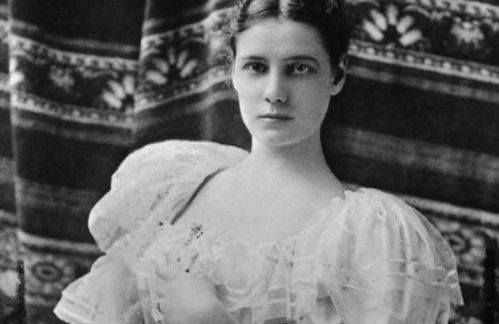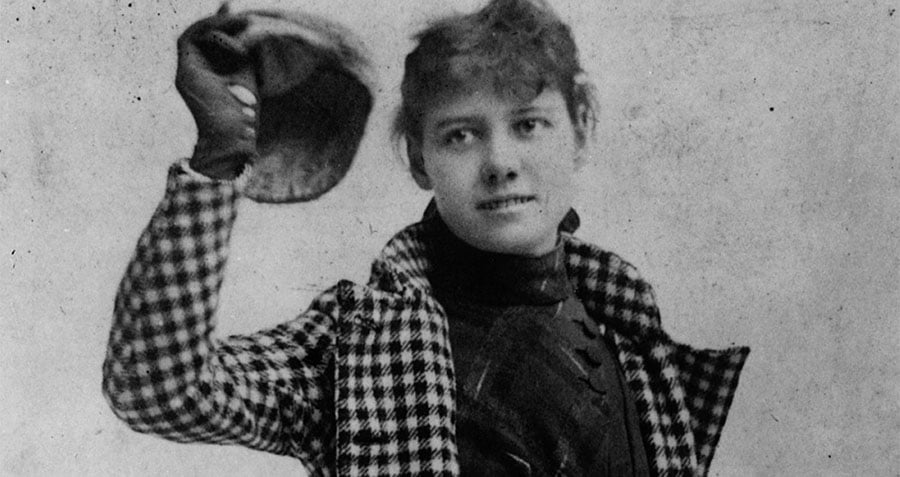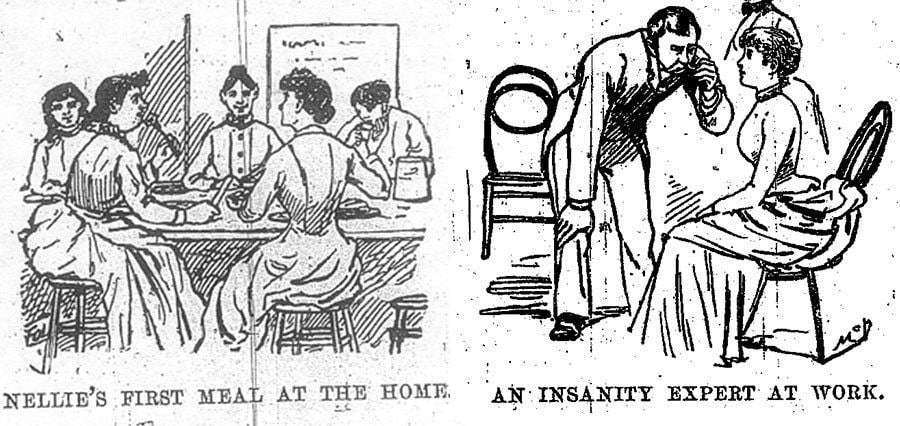The thrilling tale of perhaps the most daring undercover feat in the history of journalism by a woman named Nellie Bly.
The story of Nellie Bly, the pen name of a young reporter named Elizabeth Cochran, has been told and retold ever since she burst onto the scene in 1887. And much of this has to do with her firsthand account of life in an insane asylum.
Nellie Bly’s stint in the facility wasn’t necessarily how she envisioned making a name for herself. Indeed, it only came after successive failures.
Few New York City newspaper editors took Bly seriously — save for one potential editor at the New York World, who challenged Bly to get committed to an asylum in order to expose the dreadful conditions therein.
Nellie Bly was determined to succeed, and she did so with remarkable ease, in large part because it didn’t take much for doctors to deem a woman “hysterical” in the Victorian era.
Nellie Bly Feigns Madness

Bettmann/CORBISNellie Bly, circa 1880s-1890s.
Nellie Bly seized the editor’s assignment for a mix of personal and professional reasons. First, she viewed journalism as a device to effect positive social change and saw the mental asylum in need of that. Second, she knew that if she did this assignment correctly, it would solidify her career as a serious journalist.
Bly had been writing op-eds and “women’s interest” columns for a while at this point, but found its editorial limits stifling. She didn’t want to write about just china patterns anymore.
Bly’s ego also played a role in accepting the task: The reporter was in her early 20s at the time and conventionally attractive, and knew deep down that she could be some kind of a celebrity should she play her cards right.
Her editor, meanwhile, had his doubts. “I’m afraid about that chronic smile of yours,” he warned her. Bly replied that she would smile no more, and headed home to prepare for her mission. She spent that evening contemplating the various tropes of insanity that she knew (which were few, really) and practiced grimacing in front of her mirror.
Bly ultimately decided that she would take a piecemeal approach to getting into the asylum — not by committing a single, “hysterical” act, but by taking a series of smaller steps involving visits to poorhouses, hospitals, and police stations.
Thus, she put on her most ragged clothing and headed out to find a poorhouse that she could stay in for the night. “I went out to my crazy business,” she wrote.
When Bly arrived at the boarding house for working women, she saw an environment not dissimilar from what would greet her at the asylum. Illness ran rampant among the extremely poor residents. Cold, distant matrons served bad food to shivering residents. A collection of “nervous” women sat in the corner.
Bly hadn’t even been at the boarding home a full day before she began her act. The young reporter opted to display paranoia, and was so good at it that the woman with whom she was supposed to share a room refused.
Instead, the assistant-matron stayed with Bly, and Bly kept her act up through the night and into the next morning. While the matron slept, Bly kept herself awake by thinking of how she’d arrived at this point in her career, and imagining what would come if she pulled off this grand scheme.
“That was the greatest night of my existence,” she wrote,”For a few hours I stood face to face with ‘self’!”
The next day, the boarding home had Bly sent to the local courts for evaluation. This decision came after Bly convinced the boardinghouse matron that she didn’t quite know who she was or where she came from, but that she feared everyone and everything and had lost her trunk in her travels.
As Bly tells it, her judge — a kind, older man who decided he would “be good to her” because “she looks like my sister, who is dead” — ordered that Bly go to Bellevue Hospital for evaluation, where he likely thought someone would claim her.
The first set of doctors at Bellevue, which still operates today, thought Bly was on drugs — belladonna, specifically. Before even asking Bly how she felt, the next set accused her of being a prostitute.
By the time she arrived at a Bellevue holding unit, Bly began to suspect that the incompetence of medical professionals would follow her straight through until her journey’s end.
What Nellie Bly had not prepared for, however, was the cruelty of the nurses, and the hopelessness of her fellow patients.
Creating And Sustaining Madness

Library of Congress
Over the next several weeks of Nellie Bly’s time at Bellevue, she noticed a consistent, problematic view: If you receive public assistance, you sacrifice your ability to critique its administration.
Indeed, when Bly articulated her concerns to Bellevue staff — such as too little food, spoiled food, not enough blankets and bedding to keep warm, mistreatment and at times physical abuse — they would always tell her that “people on charity should not expect anything and should not complain.”
Bly concluded that underfunding stood at the source of these myriad problems — to the point that underinvestment could even yield violence. While at Bellevue, she became even more convinced of her mission’s value, hoping that if she succeeded, it would make a passionate and convincing argument for increased investment in public health.
And soon enough, it appeared Bly was on her way to success. After having convinced several rounds of doctors of her insanity, Bly was en route to Blackwell Island, where she would be committed. From Bly’s account, she didn’t have to do much for doctors to brand her as insane — a product, no doubt, of then-prominent diagnoses of hysteria. In fact, according to Bly she only had to slightly amp up her sense of paranoia and apparent amnesia for doctors to ship her off to the asylum.
Bly watched helplessly as doctors diagnosed other women — who were not there on a secret mission — as “lunatics,” when in fact they were all reasonably sane. In fact, many patients’ supposed “insanity” stemmed from social conditions.
Indeed, most of these women were either immigrants who did not speak English well, or at all, or had worked to the point of physical illness and exhaustion. The malnourishment, cold, and abuse they faced in the asylum did nothing to aid in their recovery.
One young woman died while Bly was there, as a direct result of staff abuse. Bly witnessed nurses beating and choking patients often, and would tell the doctors when she saw them. No one believed her.
Staff often drugged women with morphine and chloral, especially at night so they would sleep.
All of this began to take a toll on Bly’s view of the medical profession, as well as her view of herself. “I began to have a smaller regard for the ability of doctors than I ever had before, and a greater one for myself,” she wrote. This sentiment would stay with Bly for the remainder of her life.
What transpired within Blackwell’s walls alternately humbled and horrified Bly, whether it be the treatment of the patients, or the patients themselves.
“What a mysterious thing madness is,” she wrote. “I have watched patients whose lips are forever sealed in perpetual silence. They live, breathe, eat; the human form is there, but what something, which the body can live without, but which cannot exist without the body, was missing.”
For her part, she notes specifically that once she arrived at Blackwell and began covertly interviewing patients, she made no attempt to keep up her act of insanity; she behaved just as she normally did, and had a decent rapport with the physicians — flirting with at least one of them, but also noting that the doctors often flirted more with the nurses, usually at the expense of their patients’ health.
She soon grew troubled that despite her relatively “normal” behavior, doctors continued to assert that she was “demented,” and saw no hope for her to ever leave the asylum.
If anything, her sudden coherence made the doctors think she was even more unstable than when she’d arrived. But Bly knew her time was nearly up, as her editor had secured her release.
Soon, Nellie Bly would return to her “real life” to expose what she’d found. But what would become, she wondered, of the women in Blackwell who clearly did not belong there, yet had no way to escape?
Perhaps even more terrifying a thought: what would become of the women who were mentally ill,and had no choice but to remain in that hell for the rest of their natural lives?
Madness Hits The Press

University of PennsylvaniaClippings from Ten Days in a Mad-House.
Nellie Bly published her story following her release, and it went viral — to the extent that newspaper stories can.
Bly didn’t stop her efforts when the story went to print, however. She took her findings to court and demanded that they inspect Blackwell Island top to bottom.
She accompanied an entire jury to the asylum, but as the asylum had caught wind of the storm Bly intended to bring, administrators hurried to clean up their act.
When Bly arrived, indeed, staff had made improvements to the asylum’s physical appearance and dining services. They did such a thorough job of cleaning up their act that, to Bly’s horror, all of the women in Bly’s unit had inexplicably disappeared. When asked, the nurses even denied that a few of the patients (mostly those who spoke no English) had ever existed.
In spite of the institution’s sprucing-up efforts, Bly convinced the jury and Blackwell higher-ups that the place needed major reform — and the money to do so. And it happened: the institution fired several of the abjectly cruel nurses, replaced the incompetent doctors, and the City of New York gave the asylum $1,000,000 to enact further reforms.
But she did more than force change upon a mental institution; she also expanded the possibilities of journalism. At just 23 years old, Nellie Bly pioneered a new style of investigative journalism, and one in which she flourished for the better part of the next decade.
Bly eventually married a millionaire twice her age (who soon died and left his money and assets to her), attempted to recreate Jules Verne’s Around The World In 80 Days trip by herself (which she of course wrote about), and then died in 1922 at the age of 57 from, of all things, pneumonia.
Bly has gone down in history for her work inside Blackwell, and the truth is that no one else would have been able to pull it off — but that’s not necessarily because of her intrepidness.
Had one of Bly’s male contemporaries attempted to use insanity as a means to get into the nitty-gritty inner workings of insane asylums, for instance, it’s unlikely that he would have gotten far.
After all, general wisdom at the time held that men were sane until proven otherwise. As for women, the male-dominated medical profession considered them more likely to be hysterical than not, and thus women had to “prove” their sanity in ways that men would not.
As Bly found, this was often a fruitless endeavor. Had her male editor not assured her freedom, Bly mused that she may well have never left the asylum at all.
At one point in her book Ten Days in a Mad-House, Bly talks at length about the doors to each room in the ward and how nurses always had them locked. In the event of a fire, patients knew that the nurses would not be able to unlock each individual door, and thus some would perish.
When Nellie Bly’s pleas to have just the wards locked fell on deaf ears, she wrote solemnly, “Unless there is a change, there will some day be a tale of horror never equaled.”
One wonders, for those who never escaped Blackwell, if perhaps there was.
After learning about Nellie Bly and her daring reportage in America’s mental asylums, read up on Frances Farmer, tragic actress who was involuntarily committed to an asylum. Then, have a look at some haunting portraits of Victorian mental asylum patients. Finally, step inside Bedlam, London’s notoriously horrific mental asylum.





